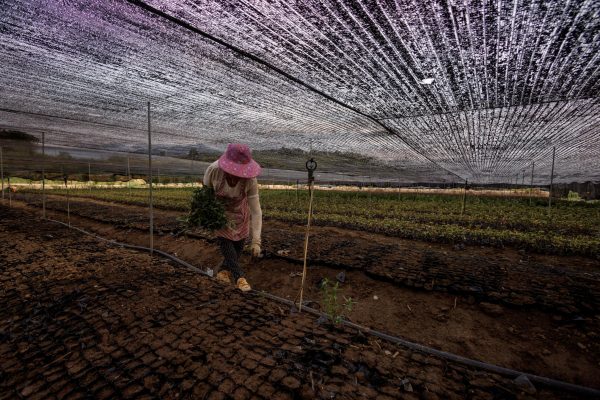In 2022, southern China suffered the country’s driest and hottest summer in six decades. The severe heatwave resulted in a massive drought, affecting an estimated 2.2 million hectares of farmland. Chinese officials are now concerned that drought could hit the Yangtze River basin, China’s main rice-growing region.
Extreme weather such as drought and floods have become major threats to China’s agricultural and food supplies. Over the past 70 years, China’s average temperature has risen faster than the global average, making the country extremely vulnerable to floods, droughts and typhoons. Extreme rainfall has reduced China’s rice yields by 8 per cent over the past two decades.
Extreme climate events are expected to occur with increasing frequency in China, jeopardising its food security plan. China’s agricultural sector is facing growing risks as a result of climate shocks and shifting planting conditions brought about by global warming.
Water shortages are the most significant and potentially most impactful component of the wider climate crisis. China will be among the most affected by water shortages. Water shortage and pollution have long been regarded as one of the top threats to the country’s food security.
Despite having the fifth-highest volume of renewable freshwater resources in the world, China’s per capita water resources were less than 25 per cent of the world average in 2018. Worse still, the country’s freshwater resources are unevenly distributed across regions — the south faces periodic floods while the north battles frequent droughts.
The shift in China’s crop structure and spatial changes in grain production has made the water challenge even more daunting. To maintain grain self-sufficiency, China increased grain production by moving production to less-developed areas within the country, mostly to the inland and northern regions. In 1995, China’s northern provinces produced 46 per cent of the country’s grain and by 2021 this share had increased to 60 per cent. Yet the northern provinces have only 24 per cent of China’s freshwater resources.
Between 1995 and 2021, grain output in the northern provinces increased by nearly 200 million tonnes, whereas grain production in the southern provinces only increased marginally. Henan, Shandong and Hebei provinces, with only 4 per cent of the country’s surface water resources, produced 24 per cent of China’s grain.
The expansion of irrigated land, especially in the north, was one of the key contributors to China’s remarkable increase in grain production over the past decades. In China’s northern provinces, where rainfall and surface water resources are low, groundwater irrigation is vital.
Reliance on groundwater has resulted in over-extraction and adverse environmental effects. Since the late 1990s, groundwater overdraft has become one of China’s most serious resource problems. Apart from water-scarcity challenges, the excessive use of chemical fertilisers and pesticides coupled with intensive farming practices have worsened land degradation and pollution.
Climate change threatens to exacerbate the water shortage, undermining China’s food security. The El Nino effect will cause increased climate uncertainty in the Yangtze River basin, causing flooding in the south, drought in the north and a cold summer in the northeast — aggravating water scarcity and regional disparities.
As the world’s largest food producer and importer, minor fluctuations in China’s domestic food production and adjustments in its agricultural trade policy heavily influence global food trade. The loss of wheat in Henan and other grain-producing provinces after the recent rain could mean China’s wheat imports reach 12 million tonnes in 2023.
The Chinese government is aware of the climate threats and water risks around providing enough food for its population and has enacted a wide range of policies in response.
The government has attempted to boost domestic grain production by providing more financial and policy support, pressing local governments to focus more on grain production and introducing stricter rules on farmland protection and usage. It has also invested heavily in agricultural technologies — from genetically modified crops to space seed breeding, alternative proteins and agricultural autonomous systems and artificial intelligence.
The government launched a nationwide campaign to cut food waste and soybean and corn use in animal feed, aiming to reduce demand for food and feed grains. It has also been undertaking various attempts to enhance its external food supply resilience through import diversification, overseas investment and by creating new supply routes and fostering international cooperation.
Facing growing threats from extreme climate events, these measures can be expected to yield mixed results. Some measures have the potential to contribute to domestic and global food supply resilience, albeit not without controversy. These measures include developing drought- and insect-resistant and salt-tolerant crops, investing in artificial or alternative proteins, boosting overseas agricultural investment and technological transfer and creating new food transportation routes.
Other measures, though, including forcefully boosting domestic grain production through intensive farming and reliance on coal-based fertiliser, will not only threaten the long-term sustainability of China’s food production but also undermine its plans to fight climate change.
Facing increasing threats from climate change, China needs to strike the right balance between boosting domestic grain production and water security. The current policy of pressuring dry northern provinces to produce more grain might make China’s food system even more vulnerable to climate shocks. Rather, China needs to tap the potential of southern rain-fed provinces to grow more grains. It is also in China’s interest to step up global agricultural investment and agricultural technology transfers.
Only through a balanced strategy that integrates regional strengths within China and leverages global agricultural cooperation can China build resilience against climate change, secure a stable food supply and maintain its key role in global food trade.
Hongzhou Zhang is Research Fellow with the China Programme at the S Rajaratnam School of International Studies (RSIS), Nanyang Technological University, Singapore.

